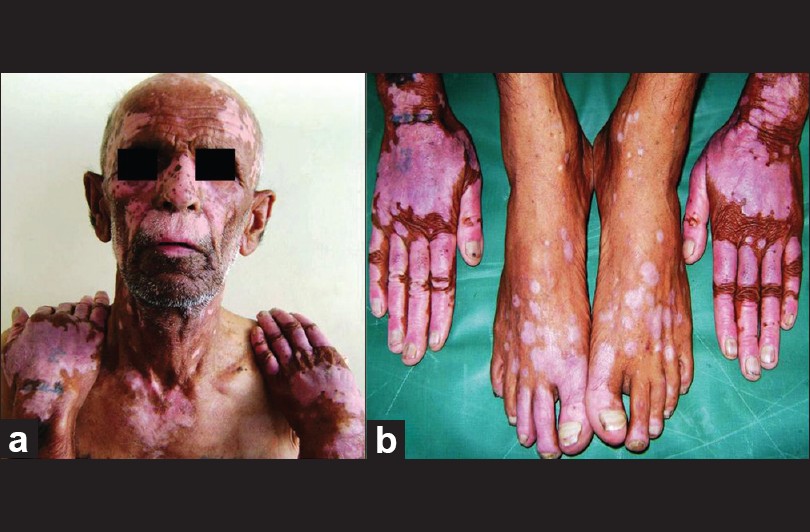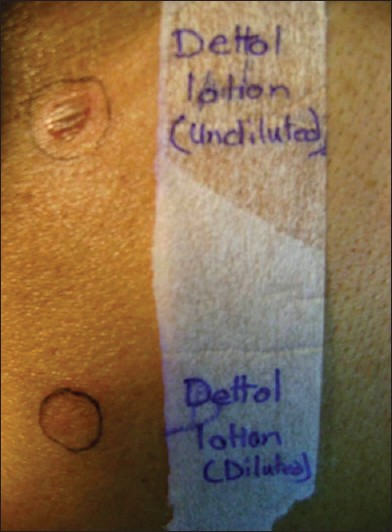Translate this page into:
Contact depigmentation following irritant contact dermatitis to chloroxylenol (dettol)
2 Department of Dermatology, Venereology and Leprosy, Dr. R.P. Govt. Medical College, Kangra (Tanda) 176 001, Himachal Pradesh, India
Correspondence Address:
Vikram K Mahajan
Department of Dermatology, Venereology and Leprosy, Dr. R.P. Govt. Medical College, Kangra (Tanda) 176 001, Himachal Pradesh
India
| How to cite this article: Verma GK, Mahajan VK, Shanker V, Tegta GR, Jindal N, Minhas S. Contact depigmentation following irritant contact dermatitis to chloroxylenol (dettol). Indian J Dermatol Venereol Leprol 2011;77:612-614 |
Sir,
Contact de-pigmentation or chemical leukoderma can occur as sequelae of either irritant or allergic contact dermatitis (ACD) that may or may not be of occupational origin. The chemicals implicated invariably are monobenzyl ether of hydroquinone, hydroquinone, tertiary butyl catechol, p-tertiary butyl phenol (PTBP), p-cresol, phenol derivatives, mercapto-amines, physostigmine, and topical minoxidil. [1],[2] The described case of contact depigmentation following irritant contact dermatitis (ICD) from chloroxylenol (dettol), a common household disinfectant, is first of its kind to the best of our knowledge.
A 65-year-old male presented with mild erythema and scaling, hyperpigmented, and depigmented patches of variable size and shape over face, ears, "V" area of neck and dorsal of hands and feet [Figure - 1]. He had applied undiluted chloroxylenol (dettol) over face, hands, and feet for itchy skin (photopruritus) and developed erythema, edema, oozing, crusting, and stinging and burning sensation that subsided over next 2 weeks with blotchy hyperpigmentation and depigmentation. He did not have history of prior topical/systemic medications or, personal or family history of vitiligo. Systemic examination and laboratory investigations were normal. A skin biopsy performed with the provisional diagnoses of contact depigmentation and disseminated discoid lupus erythematosus showed focal hyperkeratosis, epidermal atrophy, flattened rete-ridges, perivascular lymphocytic infiltrate in the upper dermis and lack of melanocytes in the basal layer. Patch testing showed no positive reaction with Indian Standard Series [3] or chloroxylenol (1% pet), but an irritant reaction to undiluted chloroxylenol occurred [Figure - 2] and the test site developed depigmentation later. Topical mometasone furate 0.1% ointment was prescribed for twice daily application.
 |
| Figure 1: (a and b) Widespread depigmentation of "V" area of neck and acro-facial skin 2 weeks after acute irritant contact dermatitis to chloroxylenol |
 |
| Figure 2: Patch-testing shows an irritant reaction to undiluted chloroxylenol |
Chemical leukoderma from occupational exposure to compounds containing PTBP, amylphenol, O-syl, vesprene in insecticides, paints, rubber, lubricating and motor oils, photographic chemicals, antimicrobials, disinfectants, soaps, detergents, deodorants, and inks has been reported often. [1] Nonoccupational chemical leukoderma reportedly occurs secondary to allergic contact dermatitis with para phenylene diamine (PPD) in hair colorants or temporary tattoos, [4],[5] methacrylates, [6] perfumes, and alstroemeria [7] or following contact with common household products such as rubber or nylon articles, spectacles, plastic watch strap, adhesives, condoms, foot wears, etc. [1] Chloroxylenol (dettol) or p-chloro-m-xylenol (PCMX), a water and oil soluble halogenated aromatic compound, is used commonly as preservative and household disinfectant or as an active agent in antimicrobial soaps. It is also used in many over-the-counter products for cuts, wounds and infections, powders, cleansers, work creams, coolant oils, linictalgraphic pastes and cosmetics. People often use it diluted/undiluted to decontaminate themselves or their environment hoping to eradicate a genuine or imagined infection, add in bathing water, apply it in inflammatory conditions especially in perineal area, or for any other dermatoses such as urticaria, generalized pruritus, xerosis, or inflammatory conditions without medical advice. It is a potential contact sensitizer and can cause localized ICD, ACD or exacerbation of pre-existing dermatitis. [8] Generalized body involvement may occur from its use in bathing water or for washing particularly when used undiluted. However, chemical leukoderma due to chloroxylenol (dettol) is rare. Malakar and Panda [9] reported widespread hypopigmentation in a car mechanic who took dettol bath on two consecutive days to treat a pustular dermatosis and developed generalized depigmentation a week later. A positive patch test to chloroxylenol (1%) and depigmentation at the patch test site in their patient suggested contact allergic dermatitis to chloroxylenol as the underlying mechanism. Negative reaction with chloroxylenol (1% in petrolatum), irritant contact reaction to undiluted chloroxylenol (as used by the patient) on patch testing and subsequent depigmentation of test site, and histologic features were suggestive of chemical leukoderma as a result of ICD in our patient. As he did not follow-up further, his primary dermatosis (cause of photopruritus?) remained unidentified.
| 1. |
Dutta AK, Dutta PK, Dhar S. Pigmentary disorders: chemical induced disorders. In: Valia RG, Valia AR, editors. IADVL Textbook and Atlas of Dermatology, 2 nd ed. Mumbai (India): Bhalani Publishing House; 2001. P. 604-5.
[Google Scholar]
|
| 2. |
Malakar S, Dhar S. Leukoderma associated with topical minoxidil: A report of two cases. Dermatology 2000;201:183-4.
[Google Scholar]
|
| 3. |
Sharma VK, Sethuraman G, Garg T, Verma KK, Ramam M. Patch testing with the Indian standard series in New Delhi. Contact Dermatitis 2004;51:319-21.
[Google Scholar]
|
| 4. |
Bajaj AK, Gupta SC, Chatterjee AK, Singh KG, Basu S, Kant A. Hair dye depigmentation. Contact Dermatitis 1996;35:56-7.
[Google Scholar]
|
| 5. |
Nikkels AF, Henry F, Piérard GE. Allergic reactions to decorative skin paintings. J Eur Acad Dermatol Venereol 2000;15:140-2.
[Google Scholar]
|
| 6. |
Casse V, Salmon-I V, Mohn C, Kalis B. Chronic depigmentation due to positive patch tests for methacrylate derivatives. Ann Dermatol Venereol 1998;125:56-7.
[Google Scholar]
|
| 7. |
Björkner BE. Contact allergy and depigmentation from alstroemeria. Contact Dermatitis 1982;8:178-84.
[Google Scholar]
|
| 8. |
Berthelot C, Zirwas MJ. Allergic contact dermatitis to chloroxylenol. Dermatitis 2006;17:156-9.
[Google Scholar]
|
| 9. |
Malakar S, Panda S. Post inflammatory depigmentation following allergic contact dermatitis to chloroxylenol. Br J Dermatol 2001;144:1275-6.
[Google Scholar]
|
Fulltext Views
15,546
PDF downloads
2,652





